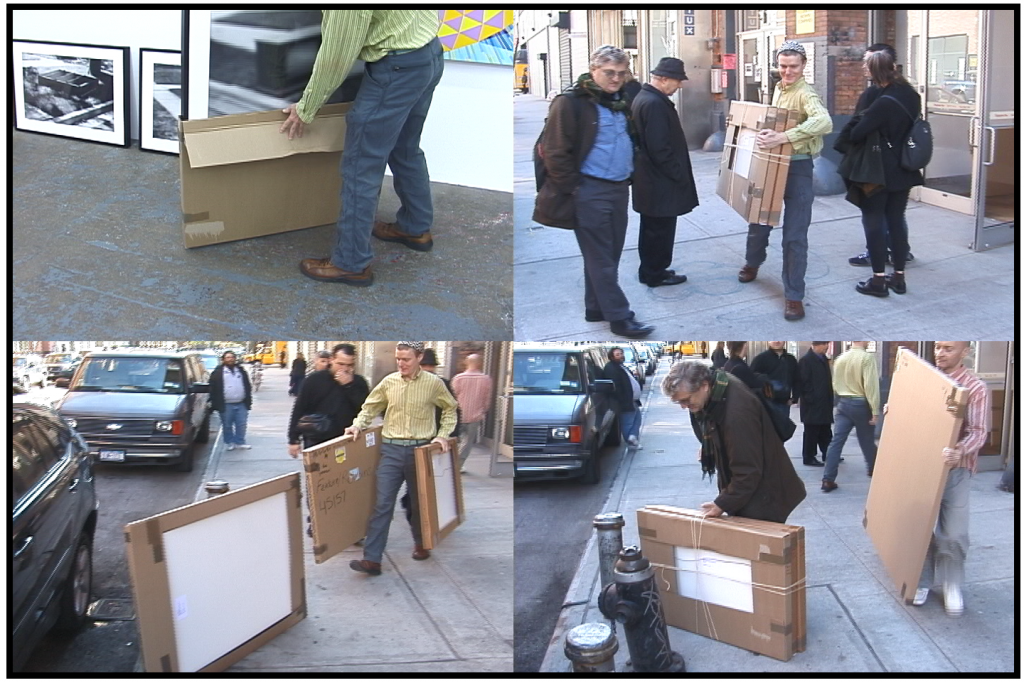CURB DECOR 2000-2003
The photographs used in the Curb Decor inkjet prints were taken over a two-year period as I went about my day in the neighborhood near my home on the north side of Milwaukee. It’s an affluent neighborhood, and a custom has evolved there where, out of respect for your neighbors, when you’re getting rid of furniture you set at the curb just one or two pieces only. With the auto-focus camera I kept stored in the glove compartment of my car, between 2000 and 2002 I made about 100 photos of these isolated pieces of curb furniture. I then began combining the photos, sometimes putting “rooms” back together, at other times discovering new relationships between the furniture depicted.
The Curb Decor series blurs three classical genres. A photograph of a piece of furniture at curbside, at the edge of a manicured suburban lawn, participates in the tradition of still life as well as landscape. The fact that the photos all depict furniture also means that each always implies the human form; furniture has no reason to exist but to serve the human form. When the photos are grouped — images placed within the context of other images — this latent content becomes more emphatic, so that the pieces then acquire the aspect of a figure study.
This is not the art of a young person, but instead, quite consciously, Middle-Aged Art. A young person wouldn’t have identified with the tragic component of these pieces sufficiently to find photographing them for two years an interesting project!
These are pictures of objects that have had a history, and that, from the evidence of their abandonment at curbside, appear now to have reached the end of their history. But unexpectedly, through art, they have found new life, a new use, and a new history. Really, then, the furniture depicted has only reached the end of the first stage of its life — its youth — and now venture. venture into new, less familiar terrain (just as we must in middle-age) to gain a new identity. They endure, not as corpus but, now, as sign.
In each photo there is thus a tragic element–after considerable contact with life, the piece of furniture has been rejected, left for dead — upon which a new layer of something other than tragedy has been imposed. The life of their usage has been transformed and extended; in that transformation and extension there is, necessarily, substantive comedy.
 These are, again consciously, suburban artworks. The settings depicted are a dual or in-between landscape, neither city nor country. This sort of landscape parallels the furniture’s own “in-between” status (“abandoned by life/rescued by art”).
These are, again consciously, suburban artworks. The settings depicted are a dual or in-between landscape, neither city nor country. This sort of landscape parallels the furniture’s own “in-between” status (“abandoned by life/rescued by art”).
I see the dual/in-between landscape of the suburb as a modern version of the frontier. It may appear tame and ordered, but psychologically and in terms of lifestyle it represents a new place to live; the modern American suburb is, after all, only a post-WWII phenomenon.
In its own way abandoned furniture too is “frontierist”. The rejection of old, familiar furniture represents the rejection of proven comfort and convenience in pursuit of the unknown, the unfamiliar — and possibly the uncomfortable and inconvenient! In the rejection of this furniture, of these symbols of comfort and convenience, I detect contemporary expression of the American habit of setting out for the wilderness.
The works I’ve made obviously have something to do with bounty and affluence. “We have so much that we can replace these objects of comfort and convenience at whim.” Photographing these objects will suggest to some that the photographer is interested in communicating a critical, photo-journalistic attitude toward suburban affluence. I have absolutely no such intention. Instead their prejudices become a material with which to play.
These are post 9/11 pieces, without question. They are an emotional expression mindful that a serious challenge to this civilization and its values is underway. Depicting things that are being thrown out, rejected, abandoned, set against backdrops of affluence, they interrogate themselves. What are our values? What have our lives been about? What do we carry forward? A ferocious attack from a foreign perspective culture has cast doubt on what we have valued. The pieces are informed by our new reality: our unconscious, complacent power pierced by a fresh and unfamiliar anxiety.
These motifs, light as well as dark, run throughout the Curb Decor series.
◆◆◆
The exhibition of these prints coincided with an ebbing of my interest in visual art and the art context — something that occurs periodically. in 2003 my interest in the exhibition format felt exhausted. So too my interest in making objects. Whether the feeling would hold for the long term there was no way of predicting, but I knew that I was done for the foreseeable. I came up with an appropriate gesture of farewell. The Curb Giveaway in front of Feature (the gallery was then in its Chelsea location) took place on November 12, 2003. Unsold Curb Decor works were packed up and placed back at the curb without ceremony, free to takers. Pictures that had started their life curbside were cycled through the gallery and unsentimentally returned to the curb.
(the gallery was then in its Chelsea location) took place on November 12, 2003. Unsold Curb Decor works were packed up and placed back at the curb without ceremony, free to takers. Pictures that had started their life curbside were cycled through the gallery and unsentimentally returned to the curb.
◆◆◆








